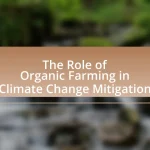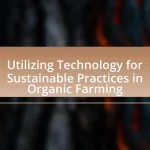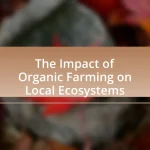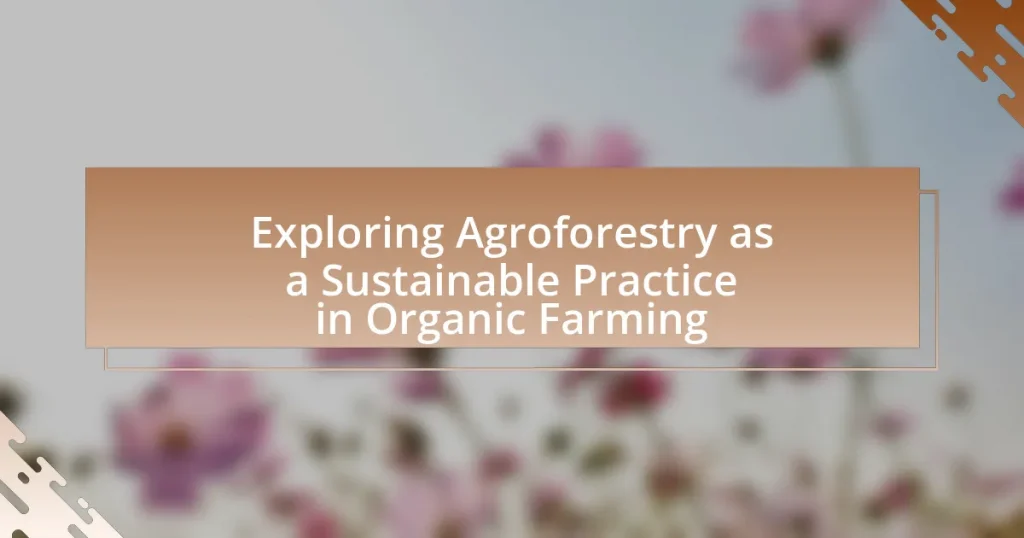Agroforestry is defined as the integration of trees and shrubs into agricultural landscapes, particularly within the framework of organic farming. This practice enhances biodiversity, improves soil health, and increases crop yields while aligning with organic farming principles by promoting ecological balance and reducing reliance on synthetic inputs. The article explores how agroforestry systems function, their environmental benefits, and the various types of agroforestry practices, such as silvopasture and alley cropping. Additionally, it addresses the challenges faced in implementing agroforestry, the role of policy in supporting these practices, and the best practices for farmers interested in adopting agroforestry in organic farming.

What is Agroforestry in the Context of Organic Farming?
Agroforestry in the context of organic farming is the integration of trees and shrubs into agricultural landscapes to enhance biodiversity, improve soil health, and increase crop yields. This practice supports organic farming principles by promoting ecological balance and reducing reliance on synthetic inputs. Research indicates that agroforestry systems can lead to improved nutrient cycling and pest management, which are essential for sustainable organic farming. For example, a study published in the journal “Agriculture, Ecosystems & Environment” found that agroforestry can increase soil organic matter by up to 30%, thereby enhancing soil fertility and crop productivity.
How does Agroforestry integrate with Organic Farming practices?
Agroforestry integrates with organic farming practices by combining trees and shrubs with crops and livestock to enhance biodiversity, improve soil health, and increase overall farm productivity. This integration allows for natural pest control, as diverse plant species can attract beneficial insects and reduce the need for synthetic pesticides, aligning with organic farming principles. Additionally, agroforestry systems can enhance nutrient cycling and water retention in the soil, which are critical for organic farming’s focus on sustainable soil management. Research has shown that agroforestry can lead to increased yields and resilience against climate variability, supporting the goals of organic farming to promote ecological balance and sustainability.
What are the key principles of Agroforestry?
The key principles of agroforestry include the integration of trees and shrubs into agricultural landscapes, promoting biodiversity, enhancing soil health, and improving ecosystem services. Agroforestry systems leverage the complementary relationships between different plant species, which can lead to increased crop yields and resilience against pests and diseases. Research indicates that agroforestry can enhance carbon sequestration, with studies showing that these systems can store up to 30% more carbon than conventional farming methods. Additionally, agroforestry practices can improve water retention and reduce soil erosion, contributing to sustainable land management.
How does Agroforestry enhance soil health in Organic Farming?
Agroforestry enhances soil health in organic farming by improving soil structure, increasing organic matter, and promoting biodiversity. The integration of trees and shrubs with crops and livestock leads to enhanced nutrient cycling, as tree roots access nutrients from deeper soil layers and contribute organic matter through leaf litter and root decay. Studies have shown that agroforestry systems can increase soil organic carbon levels by up to 30% compared to conventional farming practices, which directly contributes to improved soil fertility and water retention. Additionally, the diverse plant species in agroforestry systems support a wider range of soil microorganisms, which are essential for nutrient availability and soil health.
Why is Agroforestry considered a sustainable practice?
Agroforestry is considered a sustainable practice because it integrates trees and shrubs into agricultural landscapes, enhancing biodiversity and ecosystem services. This integration improves soil health, reduces erosion, and increases carbon sequestration, contributing to climate change mitigation. Research indicates that agroforestry systems can yield up to 30% more biomass compared to conventional farming, while also providing habitat for wildlife and promoting water conservation. Studies, such as those published in the journal “Agriculture, Ecosystems & Environment,” demonstrate that agroforestry practices can lead to improved crop yields and resilience against pests and diseases, further validating its sustainability.
What environmental benefits does Agroforestry provide?
Agroforestry provides significant environmental benefits, including enhanced biodiversity, improved soil health, and increased carbon sequestration. By integrating trees and shrubs into agricultural landscapes, agroforestry creates diverse habitats that support various species, thus promoting biodiversity. Additionally, the root systems of trees improve soil structure and fertility, reducing erosion and enhancing water retention. Research indicates that agroforestry systems can sequester up to 30% more carbon compared to conventional farming practices, contributing to climate change mitigation. These benefits collectively support ecosystem resilience and sustainability in organic farming.
How does Agroforestry contribute to biodiversity?
Agroforestry contributes to biodiversity by integrating trees and shrubs into agricultural landscapes, which enhances habitat diversity and supports various species. This practice creates microhabitats that promote the coexistence of flora and fauna, leading to increased species richness. Research indicates that agroforestry systems can host up to 50% more species compared to conventional monoculture systems, as demonstrated in studies conducted in tropical regions. Additionally, the presence of diverse plant species in agroforestry systems improves soil health and resilience, further supporting a wider range of organisms.

What are the Different Types of Agroforestry Systems?
The different types of agroforestry systems include silvopasture, alley cropping, forest farming, windbreaks, and riparian buffers. Silvopasture integrates trees, livestock, and forage, enhancing biodiversity and productivity. Alley cropping involves planting crops in rows between trees, optimizing land use and soil health. Forest farming allows for the cultivation of shade-tolerant crops under a forest canopy, promoting sustainable land management. Windbreaks consist of trees planted to protect crops from wind, reducing soil erosion and improving microclimates. Riparian buffers are vegetated areas near water bodies that help filter pollutants and stabilize banks, contributing to ecosystem health. Each system offers unique benefits that support sustainable agricultural practices.
How do different Agroforestry systems function?
Different agroforestry systems function by integrating trees and shrubs with crops and/or livestock to create a more sustainable agricultural ecosystem. These systems enhance biodiversity, improve soil health, and increase productivity through various mechanisms such as nutrient cycling, microclimate regulation, and pest control. For instance, alley cropping involves planting rows of trees alongside crops, which provides shade and reduces soil erosion while enhancing nutrient availability. Silvopasture combines trees with pastureland, allowing livestock to graze under tree cover, which improves animal welfare and land productivity. Research indicates that agroforestry can increase crop yields by 20-50% compared to conventional farming methods, demonstrating its effectiveness in promoting sustainable agricultural practices.
What are the characteristics of alley cropping systems?
Alley cropping systems are characterized by the simultaneous cultivation of crops and trees in alternating rows. This method enhances biodiversity, improves soil fertility through organic matter addition, and reduces soil erosion by providing ground cover. Additionally, alley cropping systems optimize land use by allowing for the production of both timber and food crops, which can lead to increased economic returns for farmers. Research indicates that these systems can improve microclimates and reduce the need for chemical fertilizers, thereby promoting sustainable agricultural practices.
How does silvopasture work in Agroforestry?
Silvopasture integrates trees, forage, and livestock in a single system, enhancing biodiversity and productivity in agroforestry. This practice allows livestock to graze under tree canopies, which provides shade and shelter, improving animal welfare and reducing heat stress. Additionally, the trees contribute to soil health by preventing erosion, enhancing nutrient cycling, and providing organic matter through leaf litter. Research indicates that silvopasture can increase land productivity by up to 30% compared to traditional pasture systems, demonstrating its effectiveness in sustainable organic farming practices.
What are the advantages of each Agroforestry system?
Agroforestry systems offer various advantages that enhance sustainability in organic farming. For example, alley cropping improves soil fertility and reduces erosion by integrating crops with trees, which provide shade and organic matter. Silvopasture combines livestock grazing with tree cultivation, promoting biodiversity and improving animal welfare while enhancing soil health through manure deposition. Forest farming allows for the cultivation of high-value crops under a forest canopy, optimizing land use and increasing economic returns. Lastly, windbreaks protect crops from wind damage, reduce evaporation, and enhance microclimates, leading to improved yields. Each system contributes to ecological balance, resource efficiency, and economic viability in organic farming practices.
Which Agroforestry system is best for specific crops?
The best agroforestry system for specific crops is the alley cropping system, which involves planting rows of trees or shrubs alongside crops. This system enhances soil fertility, reduces erosion, and improves microclimates for crops. Research indicates that alley cropping can increase yields of staple crops like maize and beans by up to 30% compared to conventional farming methods, as demonstrated in studies conducted in various regions, including West Africa and Southeast Asia.
How do different systems impact yield and sustainability?
Different agricultural systems significantly impact yield and sustainability through their management practices and ecological interactions. For instance, agroforestry systems, which integrate trees with crops and livestock, enhance biodiversity, improve soil health, and increase water retention, leading to higher yields compared to monoculture systems. Research indicates that agroforestry can increase crop yields by 20-50% while reducing the need for chemical fertilizers and pesticides, thus promoting sustainability. A study published in “Agriculture, Ecosystems & Environment” by Jose et al. (2018) found that agroforestry practices not only improve productivity but also contribute to carbon sequestration, enhancing environmental sustainability.
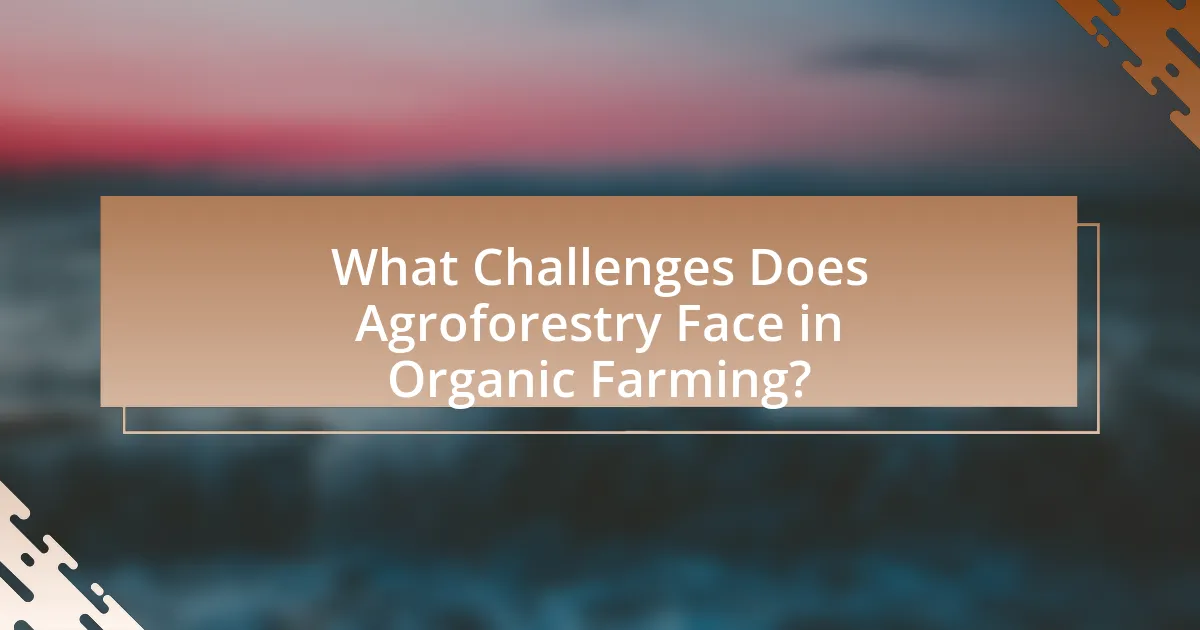
What Challenges Does Agroforestry Face in Organic Farming?
Agroforestry faces several challenges in organic farming, primarily including competition for resources, pest management, and market access. Competition for sunlight, water, and nutrients between trees and crops can hinder optimal growth and yield. Additionally, managing pests and diseases in a diverse agroforestry system can be complex, as traditional organic methods may not be as effective in such environments. Furthermore, farmers may struggle with market access for agroforestry products, as consumers often prefer conventional crops due to familiarity and availability. These challenges can impede the successful integration of agroforestry into organic farming practices.
What are the common obstacles to implementing Agroforestry?
Common obstacles to implementing agroforestry include lack of knowledge, insufficient financial resources, and land tenure issues. Farmers often lack awareness of agroforestry practices and their benefits, which hinders adoption. Financial constraints limit investment in necessary infrastructure and training. Additionally, unclear land ownership can discourage farmers from making long-term commitments to agroforestry systems. According to a study published in the journal “Agroforestry Systems,” these factors significantly impede the widespread adoption of agroforestry practices, highlighting the need for targeted education and support initiatives.
How can farmers overcome these challenges?
Farmers can overcome challenges in agroforestry by implementing integrated pest management, diversifying crops, and utilizing sustainable practices. Integrated pest management reduces reliance on chemical pesticides, promoting ecological balance and enhancing crop resilience. Diversifying crops increases biodiversity, which can lead to improved soil health and reduced vulnerability to pests and diseases. Sustainable practices, such as soil conservation techniques and water management, further support the long-term viability of agroforestry systems. Research indicates that these strategies can lead to increased yields and improved ecosystem services, demonstrating their effectiveness in addressing the challenges faced by farmers in organic farming.
What role does policy play in supporting Agroforestry?
Policy plays a crucial role in supporting agroforestry by providing frameworks that incentivize sustainable land use practices. Effective policies can promote agroforestry through financial incentives, technical support, and regulatory frameworks that encourage landowners to integrate trees into agricultural systems. For instance, the European Union’s Common Agricultural Policy includes measures that support agroforestry practices, recognizing their benefits for biodiversity, carbon sequestration, and soil health. Additionally, policies that facilitate access to markets for agroforestry products can enhance economic viability, making agroforestry a more attractive option for farmers.
How can Agroforestry practices be improved?
Agroforestry practices can be improved by integrating advanced agroecological principles and enhancing biodiversity. Implementing polyculture systems, which involve growing multiple crops and trees together, can increase resilience against pests and diseases while optimizing resource use. Research indicates that diverse systems can yield up to 20% more than monocultures due to improved nutrient cycling and pest control. Additionally, adopting agroforestry techniques such as alley cropping and silvopasture can enhance soil health and carbon sequestration, contributing to climate change mitigation. Studies show that these practices can increase soil organic matter by 1-2% annually, significantly improving soil fertility and crop productivity.
What innovations are emerging in Agroforestry techniques?
Innovations emerging in agroforestry techniques include the integration of precision agriculture technologies, such as drones and remote sensing, to optimize land use and enhance crop yields. These technologies allow farmers to monitor soil health, assess plant growth, and manage resources more efficiently. Additionally, the adoption of agroecological practices, such as intercropping and cover cropping, is gaining traction, promoting biodiversity and improving soil fertility. Research indicates that these methods can increase resilience against climate change and pests, thereby supporting sustainable farming practices. For instance, a study published in the journal “Agriculture, Ecosystems & Environment” highlights that agroforestry systems can sequester significant amounts of carbon, contributing to climate mitigation efforts.
How can technology enhance Agroforestry in Organic Farming?
Technology can enhance agroforestry in organic farming by improving resource management, increasing crop yields, and facilitating data-driven decision-making. Precision agriculture technologies, such as drones and satellite imagery, allow farmers to monitor soil health, moisture levels, and crop conditions in real-time, leading to more efficient use of water and nutrients. For instance, a study published in the journal “Agricultural Systems” found that the use of remote sensing technology can increase crop productivity by up to 20% while reducing input costs. Additionally, mobile applications can provide farmers with access to best practices and market information, fostering better integration of agroforestry systems. These technological advancements support sustainable practices by optimizing land use and enhancing biodiversity, which are critical components of organic farming.
What are the best practices for implementing Agroforestry in Organic Farming?
The best practices for implementing agroforestry in organic farming include integrating diverse plant species, optimizing land use through spatial arrangement, and enhancing soil health with organic amendments. Integrating diverse plant species, such as trees, shrubs, and crops, promotes biodiversity, which can lead to improved pest control and pollination. Optimizing land use through spatial arrangement, like alley cropping or silvopasture, maximizes productivity and resource use efficiency. Enhancing soil health with organic amendments, such as compost or cover crops, improves soil structure and fertility, supporting sustainable crop yields. These practices are supported by research indicating that agroforestry systems can increase overall farm productivity and resilience, as demonstrated in studies by the World Agroforestry Centre.
How can farmers effectively plan an Agroforestry system?
Farmers can effectively plan an agroforestry system by assessing land characteristics, selecting compatible tree and crop species, and designing the layout to optimize resource use. Conducting a thorough analysis of soil type, climate, and existing vegetation helps in choosing species that thrive together, enhancing biodiversity and productivity. For instance, integrating nitrogen-fixing trees with crops can improve soil fertility and yield. Research indicates that agroforestry systems can increase overall farm productivity by 20-50% compared to conventional farming methods, demonstrating the effectiveness of strategic planning in agroforestry.
What resources are available for farmers interested in Agroforestry?
Farmers interested in agroforestry can access a variety of resources, including government programs, educational materials, and financial assistance. The USDA’s Agroforestry Strategic Framework provides guidelines and support for implementing agroforestry practices. Additionally, organizations like the Agroforestry Research Center offer research publications and technical assistance. The National Agroforestry Center provides resources such as case studies and best management practices. Furthermore, local extension services often have tailored programs and workshops to educate farmers on agroforestry techniques. These resources collectively support farmers in adopting sustainable agroforestry practices effectively.


